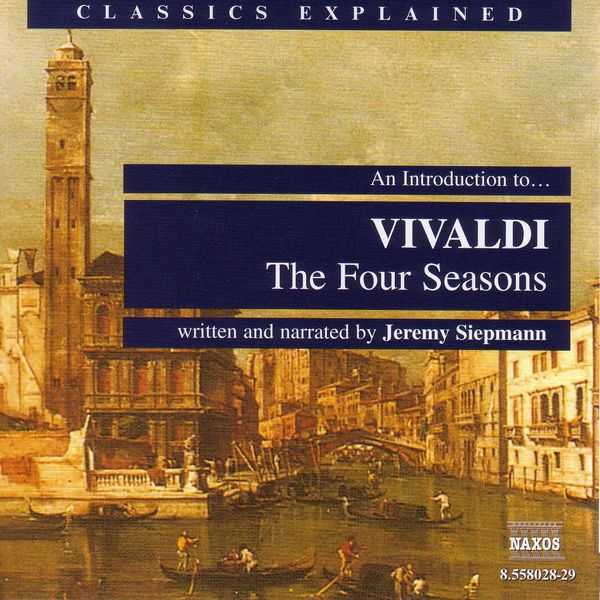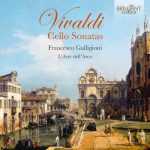
Composer: Antonio Vivaldi
Performer: Jeremy Siepmann
Format: FLAC (tracks)
Label: Naxos
Catalogue: 8558028-29
Release: 2001
Size: 455 MB
Recovery: +3%
Scan: yes
CD 01
01. Introduction: Opening, upward-pointing figure
02. Answering, downward figure completes the phrase
03. Beginning of dialogue
04. The nature of musical conversation; repetition; ‘ echo ‘ effect
05. Upward pointing to one ‘ target ‘ note
06. ‘ Answer ‘ points to two, downward notes
07. Same idea repeated 3 times
08. The first Solo section: birdsong from three soloists, not one
09. Repeat of ‘ two-pronged ‘ theme in orchestra
10. Orchestra depicts murmuring stream, but still there’s no real melody
11. Further illustrative ‘ water studies ‘
12. Orchestra erupts into thunderstorm
13. Orchestral thunder, virtuosic ‘ lightning ‘ from soloist – but still no ‘ tune ‘
14. Soloistic ‘ birds ‘ return to the air
15. Variant of opening theme, with ‘ argument ‘ between two notes, one high, one low
16. Cue to First Movement
17. First Movement (Complete)
18. Scene setting and Main Theme of Second Movement
19. Analytical comment and Main Theme again
20. Main Theme varied
21. Further variation, tracing slow, descending scale-steps
22. Analytical discussion of ‘ pace ‘ and ‘ tempo ‘ ; further variant of main theme
23. Vivaldi springs a surprise, reversing direction and heightening tension
24. Analytical cue to Second Movement
25. Second Movement (Complete)
26. Undercover ‘ bagpipes ‘ initiate the finale
27. Second part of Main Theme: new notes, same rhythm
28. An ‘ echo ‘ with a difference
29. Reminder of ‘ echoed ‘ phrase in its original form
30. Surprise variant provides springboard into new descending four-note pattern
31. Unexpected, ‘ flowing ‘ entrance of soloist
32. The use of ‘ sequence ‘ in first extended solo
33. Vivaldi prepares expectation…
34. … and frustrates it by bringing in a new theme, using his four-note ‘ motto ‘
35. Violins accompanied by flowing ‘ commentary ‘ in lower strings
36. Soloist returns with new variant
37. Pace slows as violins trace another four-note scalewise descent
38. The peasants return with the main theme, which turns unexpectedly downward
39. Intensification as harmonies change under broad, descending four-note ‘ motto ‘
40. Mini-earthquake transformed into harmonic landslide
41. Critical mood-change in soloist’s lonely soliloquy
42. Cue to restoration of main theme in its entirety as the movement ends
43. Third Movement (complete)
44. Scene setting and opening of First Movement
45. Expanded groups of answering phrase
46. Upper and lower strings alternately succumb to lethargy
47. As in ‘ Spring ‘, soloist enters with birdsong
48. Orchestra hijacks soloist’s material
49. Soloist returns,first as turtle-dove, then as goldfinch
50. Gentle breezes give away to North Wing
51. The storm subsides; soloist enters as weeping peasant boy
52. Movement ends as storm returns
53. First Movement (complete)
54. Second movement opens with extremecontrasts
55. Second Movement (complete)
56. Stormy Weather; thunder
57. Lightning from upper strings
58. More lightning: ‘ heat ‘ lightning from violins, ‘ fork ‘ lightning from violas
59. Torrential rain, depicted by entire orchestra
60. Deferred entry of solo violin, in virtuoso vein
61. Peasant’s failing resolve as violin spirals down
62. Nature triumphant; soloist draws on orchestra’s ‘rain’ music
63. The peasant’s capitulation
64. Third Movement (complete)
CD 02
01. Repetitiousness and folk music; the movement’s opening
02. Secondary theme, a closely related development of the first
03. Solo entry restates the opening theme, ‘ double-stopping ‘
04. Unexpectedly, a new theme where a repeat might be expected
05. The soloist as ‘ drunkard ‘
06. Further violinistic slips and slides
07. Orchestra re-enters with main theme, but is interrupted by the drunkard
08. Other drunks join in ‘ dialogue ‘ with the orchestra
09. The orchestral peasants continue their dancing, but things have changed
10. Enter another drunk, courtesy of the virtuoso soloist
11. The dance breaks up
12. The drunkard interrupts again, then falls asleep, breathing heavily
13. Conversation amongst the sober peasants leads to their final dance
14. First Movement (complete)
15. Scene-setting for Second Movement
16. Second Movement (complete)
17. Similarities between the Third Movement and the First
18. Expectation and surprise: Vivaldi tacks on one bar too many
19. A case of predictable unpredictablity: novelty and repetition
20. Soloist’s double-stopping depicts hunting horns
21. Orchestra yields to unexpected display of virtuosity by soloist
22. Soloist suddenly takes the part of the fleeing beast
23. Symmetrical paralels with First Movement: ‘ beast ‘ / ‘ drunkard ‘ etc
24. Death of the quarry, end of the movement
25. Third Movement (complete)
26. Orchestral strings enter, part by part; soloist depicts the biting wind
27. Wind subsides and returns, tormenting the trudgers through the snow
28. Soloist depicts snow flurries
29. Soloist’s flurries interrupted by six blasts of orchestral wind
30. Teeth chattering, and with stamping feet, the travellers finally reach their goal
31. Cue to First Movement as a whole
32. First Movement (complete)
33. Soloist’s ‘ aria ‘ accompanied by pizzicato ‘ raindrops ‘
34. A sequence of simple scales, accompanied by opening rhythm
35. Two scalewise ideas for the price of one: foreground and background
36. New, rising scale-pattern unfurled with ever-greater breadth
37. The pace increases eight-fold in concluding downwards scale
38. Against an unvarying tempo, the pace is repeatedly varied
39. Foreground / Background
40. Detailed discussion of foreground / background perceptions; analogies with speech
41. Second Movement (complete)
42. Scene-setting; soloist begins for the first time
43. Soloist rises progressively, in sequence, decoratively outling chord of the home key
44. First orchestral section; ace is halved; the undermining onset of chromaticism
45. The walkers lose their balance and stylishly fall down
46. Soloist returns as the original solitary walker and strides away from the others
47. One tempo, two rates of speed: fast for the soloist, slow for the orchestra
48. Orchestra evokes the warm winds of the Sirocco
49. Answering blast from the Borea, the could wind of the north; struggle for supremacy
50. Cue to final movement
51. Third Movement (complete)
Chromaticism in music, derived from the Greek chroma (“color”), is a compositional technique that enriches melodies and harmonies by incorporating notes outside the primary diatonic scale of a key, introducing tension, emotional depth, and tonal complexity. Originating in Renaissance and Baroque eras with composers like Gesualdo and Bach, chromaticism evolved dramatically during the Romantic period, exemplified by Wagner’s Tristan und Isolde, which pushed tonal boundaries and foreshadowed modern atonality.
This technique serves multifaceted roles: enhancing expressiveness through dissonance and resolution, enabling smooth modulations between distant keys, and adding ornamental “color” to melodies, as seen in classical works by Liszt and Mahler, jazz improvisations by Coltrane and Davis, and iconic rock songs like The Beatles’ Penny Lane.
In film scores, chromaticism builds suspense and unease, while in genres like blues and pop, it infuses soulful grit and harmonic intrigue. By balancing tension with consonance, chromaticism remains a cornerstone of musical innovation, bridging historical traditions and contemporary creativity across genres. For composers and performers, mastering its application—whether through passing tones, altered chords, or chromatic scales—unlocks limitless possibilities for emotional storytelling and sonic experimentation.



